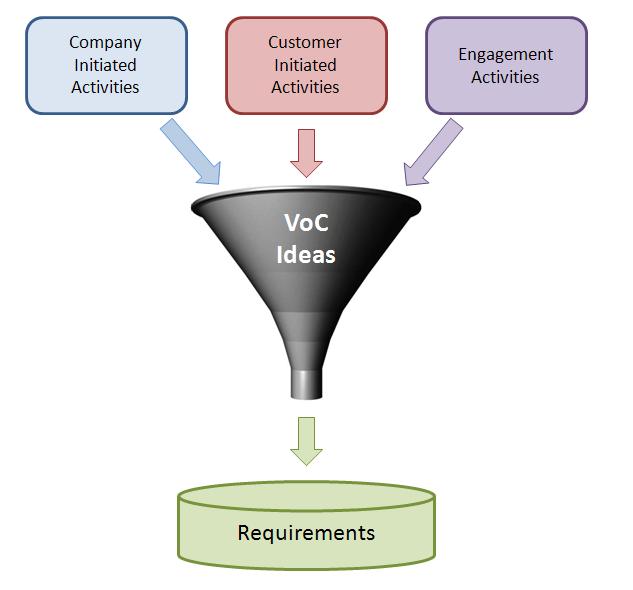NOTE: The following is a guest post from Christine Crandell. If you want to submit your own guest post, click here for more information.
—–
A well run voice- of-the customer (VoC) program can be a formidable source of ideas for new products, enhancements to existing products and untapped uses for underlying technologies. However, despite a genuine desire to effectively incorporate customer voice into product decisions, the execution is often where the obstacles lie.
In a recent study on global strategy, Forrester Research discovered that two-thirds of North American companies have VoC programs, but less than one-third actually make decisions based on customer needs.
Some of the most valuable product ideas emerge from relationships with customers and prospects. But without a consistent process for capturing and utilizing this feedback, the data gets dumped into a black hole never to be seen again.
Often customer suggestions never actually reach product managers, but remain in email, on sticky notes, or between the two ears of individuals who are not compelled to share this knowledge.
For companies committed to turning their VoC programs into a force for market differentiation, the first priority is to plug the leaky communication channels and funnel this information to Product Management.
There are 3 main sources of input for a VoC program. These are:
- Customer-initiated activities
This is feedback that is often captured in CRM and customer support systems (e.g. customer complaints, feature requests etc.) and should be integrated with product innovation ideation and idea management capabilities. - Company-initiated activities
These are typically sales and marketing related activities ranging from individual sales calls, to focus groups, user groups and customer advisory boards. - Engagement activities
These are company initiatives explicitly designed to get targeted feedback on products and product direction. These include product management led focus groups, beta programs and customer feedback portals.
 Figure 1 – Most companies are not receiving a continuous flow of customer ideas due to a broken VoC engagement channel.
Figure 1 – Most companies are not receiving a continuous flow of customer ideas due to a broken VoC engagement channel.
Your Obstacles
Without a consistent system and process for gathering data, product managers are forced to be speculative, to rely on internally generated ideas and to overlook all but the most critical components of customer feedback. “The little things” are often what makes or breaks the product.
Additionally, when a company has invited customers to participate in the co-creation of products, but then fails to act on that data, the company can lose credibility and loyalty with those customers. A typical enterprise has at least 3-4 departments that could be soliciting customers for feedback. An idea-capture system that is part of the CRM system can help integrate all touch points where customers communicate, and then make the feedback visible to constituents across the organization.
Take the following steps for implementing a successful VoC program:
Step 1: Get a Grip on Customer Touch Points
Identify every customer touchpoint within the company, where product feedback could be collected, evaluate where you’ll receive the best quality data and reach out to those department heads. Then work together to build a consistent process for feeding what customers say back to your group. There’s a good chance this will involve using technology to automatically feed a select group of records from each department’s systems into your own.
Step 2: Dive into Your Data
Hopefully by the end of step 1, you’re collecting several times as much customer feedback data as you were before. But, that can be intimidating. Take a dive into your data. Use an intern and software tools to remove duplicates, identify common themes and create compelling product strategies as well as product details.
Stick with it. This customer data offers validation behind product features that would otherwise be removed, modified or changed against the customer’s wants through the decision-making process. Remind executives and other stakeholders that your recommendations are based on what customers asked for. But also be prepared to respond to their needs in different ways and make compromises where it’s practical.
Step 3: The Execution
This is where the vast majority of VoC programs really fall flat. VoC programs need to continue running all the way through the development process, not just in early planning.
In addition to collecting feedback from pre-existing channels with customers who are passing judgment on today’s product, you have to get feedback throughout the development process based on the specific features you are incorporating.
This is why Product Managers must also have their own outlet to customers. No other department will be able to get a response from customers on the details of the features you’re currently developing. Whether it’s an online community, beta customers, or another source, Product Managers must have an outlet to publish product development updates where customers can see them and respond. This way the development team can obtain actionable guidance every step of the way.
“Build it and they will come” or so they say. And they will. It’s spectacular seeing how willing customers are to participate. Many customers will provide deep insights that an analyst or consultant could never obtain, and they do it for free. However, the process requires an attentive ear, an open mind and an analytical approach. If you have 30,000 customers, listening to all of them is no small feat.
I would urge anyone reading this to make a commitment today to get this started, create an action plan and set deadlines. Too often our daily workload prohibits us from doing the strategic work that will make products sell. This is your priority.
Christine
—–
Christine Crandell blogs regularly about product innovation on Accept Corporation’s blog The Innovation Jam. Accept provides technology companies with software to that improves profit by helping them build the right products faster.
If you want to submit your own guest post, click here for more information.